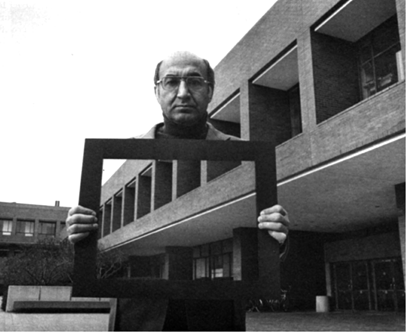|
Note: This page describes stage three of a research framework for global illumination which was first presented at a special SIGGRAPH session in August of 1997. The full text of the paper is available from the Program of Computer Graphics on-line publications.
A major goal of realistic image synthesis is to create an image that is perceptually indistinguishable from an actual scene. This is illustrated in the following image, which is not a trick photograph -- the person in the figure is holding a real physical image.

The goal of realistic image synthesis: an example from photography [STRO86]
Generating a visual image is the last stage of realistic image synthesis. At the end of the light transport process described in stage two of our framework we have a global illumination solution that represents the radiometric values at every point in a three-dimensional scene. The final stage in image synthesis involves mapping these simulated scene radiances to display radiances to produce a visual image. This is an underappreceiated and very important part of the image synthesis process that must take into account the physical characteristics of the display device, the perceptual characteristics of the observer, and the conditions under which the image will be viewed.
Physical accuracy in simulating the radiometric preperties of scenes does not guarantee that the images displayed at the end of the process will have a realistic visual appearance. Current display devices are limited in a number of ways including spatial resolution, temporal resolution, absoute and dynamic luminance range, and color gamuts. Also, the scene observer and the display observer may be in very different visual states and this can affect how they perceive the visual information before them
To produce realistic images we need to model not only the physical behavior of light, but also the parameters of perceptual response. By modeling the transformations that occur during visual processing we can develop mappings from simulated scene radiances to display radiances to produce images that are as realistic as possible. Our goal is to show that these images can be predictive of what an observer standing in the physical scene would see.
Models of visual processing will also allow us to create perceptually-based error metrics for our rendering algorithms that reduce the computational demands of rendering while preserving the visual fidelity of the rendered images.
Goals
In summary, our specific long-term goals for perceptual research are:
- Creation of photorealistic synthetic images which are preceptually indistinguishable from real scenes
- Use of perceptual metrics to establish realistic visual display methods for a wide variety of display devices and viewing conditions
- Improving the efficiency of global illumination algorithms through the utilization of perceptual error bounds
Lead Researchers
Publications
- Fabio Pellacini, James A. Ferwerda, and Donald P. Greenberg,
Toward a psychophysically based light reflection model for image synthesis,
Computer Graphics (SIGGRAPH '00 Conference Proceedings), Vol. 34, July, 2000, pp. 55-64
- Sumanta N. Pattanaik, Jack Tumblin, Hector Yee, and Donald P. Greenberg,
Time-dependent visual adaptation for realistic image display,
Computer Graphics (SIGGRAPH '00 Conference Proceedings), Vol. 34, July, 2000, pp. 47-53
- Mahesh Ramasubramanian, Sumanta N. Pattanaik, and Donald P. Greenberg,
A perceptually based physical error metric for realistic image synthesis,
Computer Graphics (SIGGRAPH '99 Conference Proceedings), (33)4, August, 1999, pp. 73-82
- Sumanta N. Pattanaik, Mark D. Fairchild, James A. Ferwerda, and Donald P. Greenberg,
Multiscale model of adaptation, spatial vision, and color appearance,
Proceedings of the 6th Color Imaging Conference, Society for Imaging Science and Technology, November, 1998, pp. 2-7
- Sumanta N. Pattanaik, James A. Ferwerda, Mark D. Fairchild, and Donald P. Greenberg,
A multiscale model of adaptation and spatial vision for realistic image display,
Computer Graphics (SIGGRAPH '98 Conference Proceedings), Vol. 32, 1998, pp. 287-298
- James A. Ferwerda, Sumanta N. Pattanaik, Peter Shirley, and Donald P. Greenberg,
A model of visual masking for computer graphics,
Computer Graphics (SIGGRAPH '97 Conference Proceedings), Vol. 31, 1997, pp. 143-152
-
James A. Ferwerda, Sumant Pattanaik, Peter Shirley, and Donald P. Greenberg.
A model of visual adaptation for realistic image synthesis.
In Holly Rushmeier, editor, SIGGRAPH 96 Conference Proceedings,
Annual Conference Series, pages 249--258. ACM SIGGRAPH, Addison Wesley,
August 1996.
-
James A. Ferwerda, Sumanta N. Pattanaik, Peter Shirley, and Donald P.
Greenberg.
A model of visual masking for computer graphics.
In Turner Whitted, editor, SIGGRAPH 97 Conference Proceedings,
Annual Conference Series, pages 143--152. ACM SIGGRAPH, Addison Wesley,
August 1997.
-
Donald P. Greenberg, Kenneth Torrance, Peter Shirley, James Arvo, James
Ferwerda, Sumanta Pattanaik, Eric Lafortune, Bruce Walter, Sing-Choong Foo,
and Ben Trumbore.
A framework for realistic image synthesis.
In Turner Whitted, editor, SIGGRAPH 97 Conference Proceedings,
Annual Conference Series, pages 477--494. ACM SIGGRAPH, Addison Wesley,
August 1997.
-
Greg Spencer, Peter Shirley, Kurt Zimmerman, and Donald Greenberg.
Physically-based glare effects for digital images.
In Robert Cook, editor, SIGGRAPH 95 Conference Proceedings,
Annual Conference Series, pages 325--334. ACM SIGGRAPH, Addison Wesley,
August 1995.
References
- [BOLI95] Mark R. Bolin and Gary W. Meyer. A Frequency Based Ray Tracer. Computer Graphics Proceedings, Annual Conference Series, 1995, ACM SIGGRAPH, pp. 409-418.
- [HURV81] L.M. Hurvich. Color Vision. Sunderland MA: Sinauer Assoc. Inc., 1981.
- [MEYE80] G.W. Meyer and D.P. Greenberg. Perceptual Color Spaces for Computer Graphics. Computer Graphics, Proceedings, Annual Conference Series, 1980, ACM SIGGRAPH, pp. 254-261.
- [MEYE86] G.W. Meyer. Color Calculation for and Perceptual Assessment of Computer Graphic Images. Unpublished Ph.D. thesis, Cornell University, 1986.
- [MITC87] D.P. Mitchell. Generating Antialiased Images at Low Sampling Densities. Computer Graphics Proceedings, Annual Conference Series, 1987, ACM SIGGRAPH, pp. 463-474.
- [STRO86] L. Stroebel, J. Compton, I. Current, and R. Zakia. Photographic Materials and Processes, Boston: Focal Press, 1986.
- [TUMB93] J. Tumblin and H. Rushmeier. Tone Reproduction for Realistic Images, IEEE Computer Graphics and Applications, 13(6), pp. 42-48, 1993.
- [WARD94b] G. Ward. A Contrast-Based Scalefactor for Luminance Display. In P.S. Heckbert (Ed.), Graphics Gems IV, Boston: Academic Press Professional, 1994.
|
